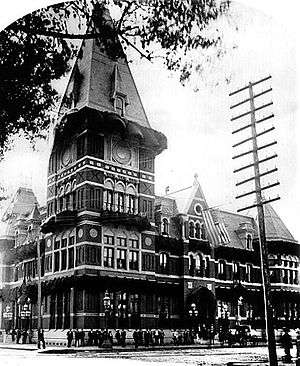Baltimore and Potomac Railroad Station
Baltimore and Potomac Railroad Station | |
|---|---|
 Baltimore & Potomac Railroad Passenger Terminal, Washington, D.C. (1873-77, Wilson Brothers & Company, architects, demolished 1908). | |
| Coordinates | Coordinates: 38°53′28.58″N 77°1′15.09″W / 38.8912722°N 77.0208583°W |
| Owned by | Baltimore and Potomac Railroad |
| Construction | |
| Structure type | At-grade |
| History | |
| Opened | 1873 |
| Closed | 1907 |
The Baltimore and Potomac Railroad Station was a railroad station that was operated by the Baltimore and Potomac Railroad in Washington, D.C., from 1873 until its closure in 1907.
History
The first B&P station in Washington was a simple wood frame structure. A more substantial brick and stone building opened in 1873 at the southwest corner of Sixth Street and B Street NW (later renamed Constitution Avenue).[1]:340 This is the present site of the West Building of the National Gallery of Art, on the National Mall.[2] The station was built over the old Washington City Canal, which complicated the construction of the foundation.[1]:340 Tracks ran south from the station along Sixth Street to a wye junction at Sixth Street SW, Maryland Avenue SW, and Virginia Avenue SW. Ironically, the tracks along Maryland Avenue ran over the Long Bridge to Virginia, and the tracks along Virginia Avenue went east into Maryland (see Landover Subdivision). On July 2, 1881, en route to catch a train to New Jersey, President James A. Garfield was shot in the back by assassin Charles Guiteau while walking across the lobby with James G. Blaine. While the president survived the initial shooting and lay bleeding on the station's floor, doctors arriving on the scene probed Garfield's wounds with non-sterilized objects in a frantic search for the bullet. The bacterial infections they introduced to the wound were the likely cause of his death in September 1881.[3]
Continuing south in Virginia was the Alexandria and Washington Railroad, opened in 1857. The Baltimore and Potomac acquired this line after reaching it, operating it until 1901, when the Washington Southern Railway (the successor of the Alexandria and Washington) was taken over by the Richmond, Fredericksburg and Potomac Railroad, an independent bridge line owned equally by the PRR and five other railroads. Soon after, in 1904, the line from the Long Bridge to Rosslyn, built by the Washington Southern, was split off into the Rosslyn Connecting Railroad, owned by the PRR.
References
- 1 2 Wilson, William Bender (1895). History of the Pennsylvania Railroad Company: With Plan of Organization. Philadelphia: Henry T. Coates & Company.
- ↑ Goode, James W. Capital Losses: A Cultural History of Washington's Destroyed Buildings. 2d ed. Washington, D.C.: Smithsonian Books, 2003. ISBN 1-58834-105-4.
- ↑ Baker, Kevin (2011-09-30). "Destiny of the Republic — By Candice Millard — Book Review". The New York Times. ISSN 0362-4331. Retrieved 2015-10-23.
